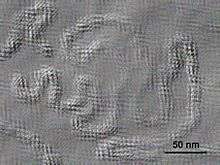Ophioviridae
| Ophioviridae | |
|---|---|
 | |
| Electron microscopy of the Citrus psorosis virus. | |
| Virus classification | |
| Group: | Group V ((−)ssRNA) |
| Order: | Unassigned |
| Family: | Ophioviridae |
| Genera | |
Ophioviridae is a family of viruses characterized by an elongated and highly filamentous and flexible nucleocapsid with helical symmetry.[1][2]
The protein capsid is non-enveloped and has a constant diameter of 1500–2500 nm and a width of 3 nm, or 9 nm. The capsids form kinked circles, which can collapse to form linear duplex structures, much like a spring.[2]
The entire genome is 1100–1200 nucleotides long.[2][3]
Taxonomy
The family has one genus, Ophiovirus, which has seven recognized species. Members of both the family and the genus are referred to as ophioviruses.[2]
- Order Unassigned
- Family Ophioviridae
- Genus Ophiovirus
- Species:
- Blueberry mosaic associated virus
- Citrus psorosis virus (type species)
- Freesia sneak virus
- Lettuce ring necrosis virus
- Mirafiori lettuce big-vein virus
- Ranunculus white mottle virus
- Tulip mild mottle mosaic virus
- Species:
- Genus Ophiovirus
- Family Ophioviridae
References
- ↑ García, María Laura; Bó, Elena Dal; da Graça, John V.; Gago-Zachert, Selma; Hammond, John; Moreno, Pedro; Natsuaki, Tomohide; Pallás, Vicente; Navarro, Jose A.; Reyes, Carina A.; Luna, Gabriel Robles; Sasaya, Takahide; Tzanetakis, Ioannis E.; Vaira, Anna María; Verbeek, Martin (21 June 2017). "ICTV Virus Taxonomy Profile: Ophioviridae". Journal of General Virology. doi:10.1099/jgv.0.000836.
- 1 2 3 4 "ICTV Report Ophioviridae".
- ↑ ICTVdB Management (2006). 00.094.0.01. Ophiovirus. In: ICTVdB—The Universal Virus Database, version 4. Büchen-Osmond, C. (Ed), Columbia University, New York, USA.
External links
This article is issued from
Wikipedia.
The text is licensed under Creative Commons - Attribution - Sharealike.
Additional terms may apply for the media files.